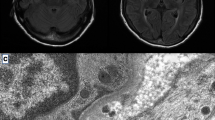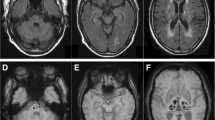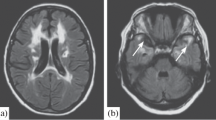Abstract
Cerebral autosomal dominant arteriopathy with subcortical infarcts and leukoencephalopathy (CADASIL) is a non-arterio-atherosclerotic, non-amyloidotic arteriopathy affecting preferentially the small arteries and arterioles of the brain. The morphologic hallmark is the presence of a characteristic granular alteration of the arterial media that ultrastructurally corresponds to the accumulation of electron-dense material surrounding the smooth muscle cells. Although the presence of this granular osmiophilic material (GOM) was originally described as limited to brain vessels, identical electron microscopic findings have been demonstrated in the media of peripheral tissue arteries, allowing for a pathologic diagnosis of the disease by a simple skin, muscle or nerve biopsy. We report some atypical features identified in our CADASIL patients that broaden the phenotypic expression of this disease. Firstly, we identified a cortical infarct in an otherwise typical CADASIL patient. Secondly, we observed GOM in skin arteries of a 30-year-old man with hemiplegic migraine, the son of a woman who had died with CADASIL. This confirms that it may be possible to diagnose the disease at a preclinical stage by the ultrastructural evaluation of peripheral tissue biopsy material, particularly for individuals for whom there is a supporting family history. Thirdly, ultrastructural examination of the skin, and subcutaneous and striated muscle of an unrelated and apparently sporadic patient with neuropathologic and neuroradiologic evidence of CADASIL in meningeal and cerebral vessels failed to reveal diagnostic lesions in peripheral arteries. Thus, the possibility of a false-negative pathologic diagnosis in patients with a clinicoradiologic diagnosis of CADASIL, if one relies solely on a peripheral tissue biopsy, does exist. Additionally, we have identified heat shock proteins (Hsp70 and αB crystallin) and ubiquitin in the vascular myocytes of affected arteries. αB crystallin also seemed to be deposited extracellularly, which suggests that GOM also might be immunoreactive for αB crystallin.
Similar content being viewed by others
Author information
Authors and Affiliations
Additional information
Received: 9 December 1996 / Revised, accepted: 21 February 1997
Rights and permissions
About this article
Cite this article
Rubio, A., Rifkin, D., Powers, J. et al. Phenotypic variability of CADASIL and novel morphologic findings. Acta Neuropathol 94, 247–254 (1997). https://doi.org/10.1007/s004010050700
Issue Date:
DOI: https://doi.org/10.1007/s004010050700




